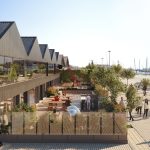Lisbon’s urban revival
Twenty years ago this month, Expo ’98 opened on a dockland site in the east of Lisbon, previously used for oil storage and as a rubbish dump. The emphasis was on urban renewal, on bringing the city back into contact with the river and on developing an alternative centre for offices and apartments.
Contrary to fears at the time, the redevelopment was a success. Expo ’98 not only had the power to sell plots, it could also grant planning permission and local developers were keen to avoid the legendary delays and bureaucracy of the Lisbon planning department.
The government ensured that there was good access by road and rail to the new centre, from in and around Lisbon, and now more than 25,000 people live or work in the area.
As Expo was finishing, the Washington-based businessman Anthony Lanier came to Portugal. He was looking for a good long-term investment opportunity and asked Pedro Seabra, then the CEO of CB Richard Ellis, for advice.
Pedro knew that Lisbon was full of rundown buildings that could one day be refurbished and that, after a century of rent control, the owners were losing money on their properties and would be happy to sell if the terms were right.
Anthony decided to concentrate on the area around the gardens in the Príncipe Real square and suceeded in buying 25 buildings over a 20-year period.
“I have never seen such an opportunity for revitalisation of such magnitude as I found in Lisbon,” he says. “I have never seen a city with such a fabric and light, and I have never had a chance to bring about change on such a scale.” He was prepared to invest for the long term and to put down roots among the local people.
Lots of talk but little action
For the first 10 years, there was a lot of talk about revitalisation of the inner city but little action. A redevelopemt agency was set up in Porto, but it was under-funded and was limited to a small downtown area.
For such change to happen, Anthony needed, first of all, a change in the law, and the first chink of light appeared in 2006. A new law for residential lettings was passed under the auspices of the current Prime Minister António Costa who was then Home Secretary.
The law provided that landlords could raise all rents which were previously frozen but with a moratorium of 10 years, and certain tenants, such as those aged 65 or more, were excepted. That law was amended in 2012 and again in 2017, so that the maximum rent which a landlord could charge at the end of the moratorium was one-fifteenth of the rateable value of the property and the moratorium for the aged and infirm was extended to 2023.
These changes would not in themselves have been sufficient to shake up central Lisbon and Porto, but, in the last five years, Portugal has witnessed an explosion in tourism. Both cities have become trendy and the country has won numerous awards as the best place to visit. In little more than a decade, arrivals at Lisbon airport have doubled. Demand for hotels and tourist apartments has risen exponentially and international investors have been attracted to the two cities.
Recent new arrivals in Portugal who are developing a series of projects include Claude Berda, a French publisher whose Vanguard Properties has invested more than €600 million in 15 developments in Portugal in the last three years, and the Spanish fund manager Andbank, which recently launched a €50 million fund jointly with Portuguese developer Quantico to invest in Lisbon prime property. Quantico currently has five refurbishment projects in Lisbon.
Some opposition but the boom will go on
In a recent article in the Diário de Notícias, Fernanda Câncio described how a building in her street in central Lisbon, which had been in the same family for five generations, had been sold for €3 million. Some of the tenants had lived there for more than 40 years, but all were being given notice to quit and the electricity and cleaning of the common parts had been stopped.
There has been plenty of opposition to the evictions, but the majority recognise that more frozen rents will only lead to more dilapidated buildings and a way has to be found to protect tenants without demotivating owners from renting out their properties on a long-term basis.
For the foreseeable future, the boom in restoration projects is going to continue. The weight of money behind them is just too strong, and the local councils and the government are both benefitting enormously. Despite a concessionary rate of VAT and some exemption from local rates for building restoration works, it is estimated that at least 20% of the price of each apartment sold goes to local and central government through transfer taxes, local authority fees, VAT and profits taxes.
Anthony Lanier has seen his long-term investment pay off. He has already succeeded in changing the face of Lisbon and most residents and visitors are grateful for his long-term vision.










